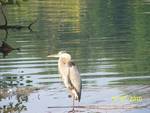diapered husband
July 14, 2010Birthday
July 16, 2010 Thought this was a cute little fellow took this pic over fourth of July he was just sitting all by his self not a care in the world. But then again maybe he does anyways did some research and this is what i found out about him hope you enjoy this.
Thought this was a cute little fellow took this pic over fourth of July he was just sitting all by his self not a care in the world. But then again maybe he does anyways did some research and this is what i found out about him hope you enjoy this.
This long-legged, S-necked white bird is found throughout the Americas and around much of the world. It is typically the largest white egret occurring anywhere in its range (only the white-colored form of the great blue heron is larger).
Great egrets are found near water, salt or fresh, and feed in wetlands, streams, ponds, tidal flats, and other areas. They snare prey by walking slowly or standing still for long periods, waiting for an animal to come within range of their long necks and blade-like bills. The deathblow is delivered with a quick thrust of the sharp bill, and the prey is swallowed whole. Fish are a dietary staple, but great egrets use similar techniques to eat amphibians, reptiles, mice, and other small animals.
These birds nest in trees, near water and gather in groups called colonies, which may include other heron or egret species. They are monogamous, and both parents incubate their three to four eggs. Young egrets are aggressive towards one another in the nest, and stronger siblings often kill their weaker kin so that not all survive to fledge in two to three weeks.
The great egret is the symbol of the National Audubon Society and represents a conservation success story. The snowy white bird’s beautiful plumage made it far too popular in 19th-century North America. Great egrets were decimated by plume hunters who supplied purveyors of the latest ladies’ fashions. Their populations plunged by some 95 percent. Today the outlook is much brighter. The birds have enjoyed legal protection over the last century, and their numbers have increased substantially
Minnie






